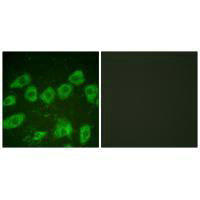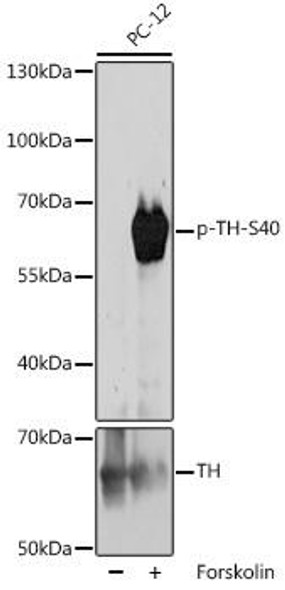| UniProt Protein Function: | TH: an enzyme involved in the conversion of phenylalanine to dopamine. As the rate-limiting enzyme in the synthesis of catecholamines, tyrosine hydroxylase has a key role in the physiology of adrenergic neurons. Four splice variant isoforms have been described. Protein type: Endoplasmic reticulum; Oxidoreductase; Vesicle; Amino Acid Metabolism - tyrosine; Mitochondrial; EC 1.14.16.2Chromosomal Location of Human Ortholog: 11p15.5Cellular Component: cytoplasm; cytoplasmic vesicle; cytosol; dendrite; internal side of plasma membrane; melanosome membrane; mitochondrion; neuron projection; nucleus; perikaryon; smooth endoplasmic reticulum; synaptic vesicle; terminal buttonMolecular Function: amino acid binding; dopamine binding; enzyme binding; ferric iron binding; ferrous iron binding; oxygen binding; protein binding; protein domain specific binding; tyrosine 3-monooxygenase activityBiological Process: anatomical structure morphogenesis; catecholamine biosynthetic process; cerebral cortex development; circadian sleep/wake cycle; dopamine biosynthetic process; dopamine biosynthetic process from tyrosine; eating behavior; embryonic camera-type eye morphogenesis; epinephrine biosynthetic process; eye photoreceptor cell development; fatty acid metabolic process; glycoside metabolic process; heart development; heart morphogenesis; isoquinoline alkaloid metabolic process; learning; locomotory behavior; mating behavior; memory; multicellular organismal aging; neurotransmitter biosynthetic process; norepinephrine biosynthetic process; organ morphogenesis; phthalate metabolic process; phytoalexin metabolic process; pigmentation; regulation of heart contraction; response to activity; response to amphetamine; response to corticosterone stimulus; response to electrical stimulus; response to estradiol stimulus; response to ethanol; response to ether; response to herbicide; response to hypoxia; response to light stimulus; response to lipopolysaccharide; response to nutrient levels; response to peptide hormone stimulus; response to pyrethroid; response to salt stress; response to water deprivation; response to zinc ion; sensory perception of sound; social behavior; sphingolipid metabolic process; synaptic transmission, dopaminergic; synaptic vesicle amine transport; terpene metabolic process; visual perceptionDisease: Segawa Syndrome, Autosomal Recessive |
| UniProt Protein Details: | |
| NCBI Summary: | The protein encoded by this gene is involved in the conversion of tyrosine to dopamine. It is the rate-limiting enzyme in the synthesis of catecholamines, hence plays a key role in the physiology of adrenergic neurons. Mutations in this gene have been associated with autosomal recessive Segawa syndrome. Alternatively spliced transcript variants encoding different isoforms have been noted for this gene. [provided by RefSeq, Jul 2008] |
| UniProt Code: | Q2M3B4 |
| NCBI GenInfo Identifier: | 88900501 |
| NCBI Gene ID: | 7054 |
| NCBI Accession: | NP_954986.2 |
| UniProt Secondary Accession: | Q2M3B4,Q0PWM2, Q0PWM3, Q15585, Q15588, Q15589, Q2M3B4 B7ZL70, B7ZL73 |
| UniProt Related Accession: | Q2M3B4,P07101 |
| Molecular Weight: | |
| NCBI Full Name: | tyrosine 3-monooxygenase isoform a |
| NCBI Synonym Full Names: | tyrosine hydroxylase |
| NCBI Official Symbol: | TH |
| NCBI Official Synonym Symbols: | TYH; DYT14; DYT5b |
| NCBI Protein Information: | tyrosine 3-monooxygenase |
| UniProt Protein Name: | Tyrosine 3-monooxygenase |
| UniProt Synonym Protein Names: | Tyrosine 3-hydroxylase; TH |
| Protein Family: | |
| UniProt Gene Name: | TH |
| UniProt Entry Name: | TY3H_HUMAN |









